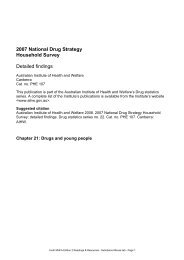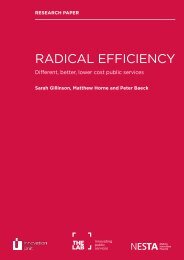A Guide To What Works For Anxiety Disorders - Mental Health First Aid
A Guide To What Works For Anxiety Disorders - Mental Health First Aid
A Guide To What Works For Anxiety Disorders - Mental Health First Aid
Create successful ePaper yourself
Turn your PDF publications into a flip-book with our unique Google optimized e-Paper software.
Breathing trainingOur ratingOur ratingGAD? Panic Disorder and Agoraphobia ?PTSD and ASD? Specific Phobias ?Social Phobia? OCD ?WHAT IS IT?Breathing training teaches correct breathing habits to people withanxiety disorders. It is also known as 'breathing retraining'. It is mainlyused to treat panic attacks or for control of hyperventilation.HOW IS IT MEANT TO WORK?People with anxiety disorders are thought to have abnormal breathingpatterns. They may breathe faster and deeper than necessary,particularly during a panic attack and have high levels of carbon dioxidein the blood. This may increase anxiety. As breathing training helpsto correct these breathing habits, it may also help to reduce anxiety.Breathing training may also help people feel as if they have morecontrol of their anxiety. Breathing training can be used by itself or incombination with other treatments.DOES IT WORK?Panic Disorder and AgoraphobiaSeveral studies have looked at the effect of breathing training in PanicDisorder. The studies that looked at breathing training alone did showsome benefit. However, these studies did not use control (no-treatment)groups and it is not possible to draw conclusions. Some other studieshave compared breathing training with other psychological treatments.The better-quality studies suggested that breathing training was not aseffective as psychological treatments such as CBT.Other anxiety disordersThere is no evidence on whether breathing training works for GAD,PTSD, Social Phobia, Specific Phobias or OCD.ARE THERE ANY RISKS?There are no known risks.Caffeine reduction or avoidanceOur ratingOur ratingGAD? Panic Disorder and Agoraphobia ?PTSD and ASD? Specific Phobias ?Social Phobia? OCD ?WHAT IS IT?Caffeine is a nervous system stimulant. It can be found in coffee, tea,cola, and chocolate.HOW IS IT MEANT TO WORK?Caffeine may cause anxiety because it blocks the action of a substancein the brain that calms the body. Consuming large amounts ofcaffeine can cause similar symptoms to anxiety (e.g. restlessness,nervousness). Hence, reducing or going without caffeine could behelpful for those with anxiety disorders.DOES IT WORK?Several studies have shown that consuming caffeine after a caffeinefreeperiod briefly increases anxiety in those with Panic Disorder, GAD,or Social Phobia. However, reducing caffeine has not been properlyevaluated in well-designed studies. There are only reports of treatmentswith a single person (case studies) in which reducing caffeine haslowered anxiety levels.There is no evidence on whether caffeine reduction or avoidance worksfor PTSD, Specific Phobias or OCD.ARE THERE ANY RISKS?Symptoms of caffeine withdrawal include headache, fatigue, decreasedenergy and alertness, depressed mood, problems concentrating andfeeling irritable. These symptoms may last for two to nine days.RECOMMENDATIONThere is not enough good evidence to say whether reducing oravoiding caffeine works.RECOMMENDATIONThere is not enough evidence to say whether breathing training iseffective in treating anxiety disorders.44




